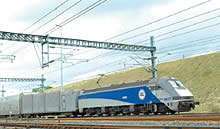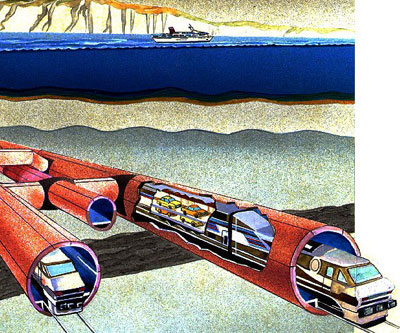The Channel Tunnel, also known as Chunnel or Eurotunnel, is the undersea rail tunnel, running beneath the English Channel at the Strait of Dover, connecting Folkestone, Kent in the United Kingdom with Coquelles, Pas-de-Calais near Calais in northern France.
- The first ever proposal for a tunnel between the UK and France was put forward by a French mining engineer named Albert Mathieu back in 1802.
- The Channel Tunnel is one of Europe's biggest infrastructure projects ever.
- In designing the tunnel lining, a total of 18 design development studies were carried out to ensure that no aspect of the system's operation was overlooked. The lining of the tunnel was designed for endurance for a 120 year period. A sum total of 13000 engineers, workers and technicians came together in the construction of the tunnel.
- It consists of three interconnected tubes. One rail track each way and a small service tunnel.
- The two main tunnels are 30m apart.
- Its length is 50.5-kilometre (31.4 mi) of which 37.9 kilometres (23.5 mi) are under water.
- The tunnel goes to as deep as 75 metres (250 ft) deep beneath the sea bed. The undersea tunnels are an average of 50m below the seabed
- It takes only 20 minutes to cover the length of tunnel under the sea.
- 84Km of tunnels were constructed on the English side and 69Km on the French side.
- The French undersea tunnels were lined with a water-tight bolted and gasketed segmental concrete lining. The English tunnel lining was a concrete expanded segmental lining. The voids behind the lining were grouted to control water ingress.
- The Running Tunnels have a 8.2m outer, and 7.6m inner diameter while the Service Tunnel has a 5.0m inner diameter.
- The two Running Tunnels each carry a single track railway and these are connected to the Service Tunnel by Cross Passages every 375m
- Eurotunnel shuttle locomotives are among the most powerful locomotives in the world - generating up to 7,500 horsepower and hauling trains of up to 2,400 tonnes at speeds of up to 85mph.
- Two caverns were excavated undersea to allow trains to change tunnels if required. These are known as the English and French Crossovers.
- 6 tunnel boring machines were used on the English side and 5 on the French side. The English machines were 'open face' while the French were 'earth pressure balance' machines.
- The tunnel system is kept dry by five pumping stations and sumps, three built under the sea and one on each shore. An unusual feature in the rail tunnels is the installation of a cooling system designed to counteract the buildup of heat produced by fast-moving trains. Chilled water is pumped through cooling pipes so that the tunnel air is maintained at a comfortable temperature.
-
 The volume of rubble removed from the tunnel is three times greater than the Chepos Pyramid in Egypt and increased the size of Britain by 90 Acres (equivalent to sixty eight football fields). This area has been made into a park.
The volume of rubble removed from the tunnel is three times greater than the Chepos Pyramid in Egypt and increased the size of Britain by 90 Acres (equivalent to sixty eight football fields). This area has been made into a park.
